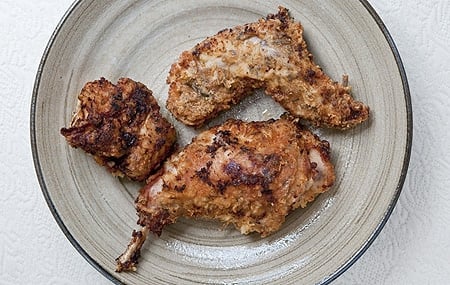
If you are blessed with a young cottontail rabbit or very young snowshoe hare or jackrabbit (look for white teeth and ears that tear easily), you can do what anyone who buys a domestic bunny can do: Fry it like a chicken.
This is a fried rabbit recipe based on a buttermilk fried chicken recipe from my friend Elise at Simply Recipes. I kicked up her spice mix by adding more garlic, cayenne and paprika, thus the red color.
You need a lot of oil for this, but you can reuse it a few times. When you’re done, let the oil cool and then pour it through a fine-mesh strainer with a piece of paper towel set inside it that has been set over a bowl or large measuring cup. The paper towel will filter the brown bits and you can just pour the strained oil back into the container.
Most rabbits are sold whole, and if you don’t know how to get them into serving pieces, here is a primer on how to cut up a rabbit.
[recipe_name]buttermilk fried rabbit[/recipe_name]
[summary]I highly recommend you brine your rabbits before frying. A simple brine of 1/4 cup kosher salt to 4 cups water will do — the rabbit is going to get plenty of seasoning later. Submerge your bunny in this brine for up to 12 hours.
As a general rule, 1 domestic rabbit will serve 2-3, as will a jackrabbit. A snowshoe hare will serve 2, a cottontail about 1 1/2, and a squirrel just one.[/summary]
[yield]Serves 4.[/yield]
Prep Time:[preptime time=8H] 8 hours[/preptime]
Cook Time: [cooktime time=45M] 45 minutes[/cooktime]
- [ingredient][amount]2[/amount] domestic [item]rabbits[/item] or 3 cottontails, cut into serving pieces [/ingredient]
- [ingredient][amount]2 cups[/amount] [item]buttermilk[/item][/ingredient]
- [ingredient][amount]2 tablespoons[/amount] [item]Italian seasoning[/item], or 1/2 cup of mixed chopped fresh herbs like oregano, thyme and parsley[/ingredient]
- [ingredient][amount]1 tablespoon[/amount] [item]paprika[/item][/ingredient]
- [ingredient][amount]1 tablespoon[/amount] [item]garlic powder[/item][/ingredient]
- [ingredient][amount]2 teaspoons[/amount] [item]cayenne[/item][/ingredient]
- [ingredient][amount]2 cups[/amount] [item]flour[/item][/ingredient]
- [ingredient][amount]1 teaspoon[/amount] [item]salt[/item][/ingredient]
- [ingredient][amount]2 cups[/amount] [item]vegetable oil[/item][/ingredient]
[instructions]
- Mix the buttermilk with the all the spices except the teaspoon of salt and the flour. Coat the rabbit with the mixture and set in a covered container overnight, or at least 8 hours.
- When you are ready to fry, pour the oil into a large pan — a big cast iron frying pan is ideal — and heat over medium-high heat. The general idea is you want the oil to come halfway up the side of the rabbit.
- Meanwhile, take the rabbit out of the buttermilk and let it drain in a colander. Don’t shake off the buttermilk or anything, just leave it there.
- Let the oil heat until it is about 325 degrees; this is the point where a sprinkle of flour will immediately sizzle. Do not let the oil smoke!
- When the oil is hot, pour the flour and salt into a plastic bag and shake to combine. Put a few pieces of rabbit into the bad and shake to get it coated in flour.
- Fry for 12-15 minutes. Fry gently — you want a steady sizzle, but nothing raging, and you definitely don’t want the rabbit to just sit in oil. You might need to adjust the heat a bit.
- Turn the rabbit pieces and fry for another 10-12 minutes. The belly flap pieces and the forelegs will come out first, followed by the loin, and the hind legs will come out last.
- You will probably need to fry in batches, so just leave the rabbit pieces in the colander until you are ready to flour them up and fry them. Don’t let the floured pieces sit.
- When the rabbit is good and fried, let them rest on a rack set over a paper towel to drain away any excess oil.
- Serve hot or at room temperature.